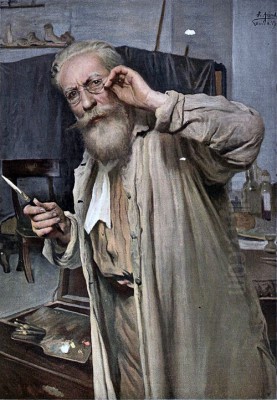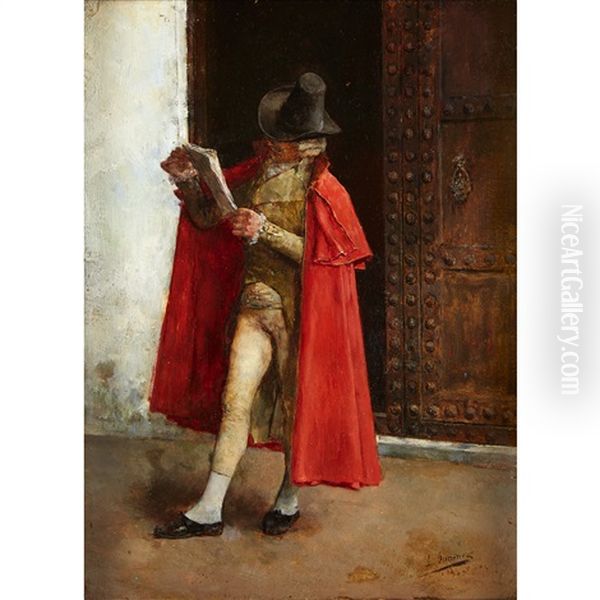
José Jiménez y Aranda stands as a significant figure in the landscape of 19th-century Spanish art. Born in the vibrant city of Seville on February 7, 1837, and passing away in his native city on May 6, 1903, his life spanned a period of rich artistic development and transition in Spain and across Europe. Primarily known as a painter of genre scenes and historical subjects, as well as a prolific illustrator, Jiménez y Aranda navigated the currents of Academicism, Romanticism, and Realism, forging a distinctive style marked by meticulous detail, technical brilliance, and insightful observation of Spanish life.
Early Life and Artistic Formation in Seville
Seville, with its rich artistic heritage, provided the initial backdrop for Jiménez y Aranda's development. He enrolled at the Royal Academy of Fine Arts of Saint Elizabeth of Hungary (Real Academia de Bellas Artes de Santa Isabel de Hungría) in Seville, a prestigious institution that nurtured many talents. Here, he received foundational training under respected masters who shaped the Andalusian art scene.
His principal instructors included Antonio Cabral Bejarano, a notable painter known for his Romantic and costumbrista works, and Eduardo Cano de la Peña, a history painter celebrated for his academic precision and grand compositions. Manuel Barrón y Carrillo, a landscape painter associated with the Seville school, also contributed to his artistic education. This training instilled in him a strong grounding in drawing, composition, and the academic principles that would underpin his later work, even as he embraced more modern influences.
Broadening Horizons: Madrid, Rome, and Key Influences
Seeking wider opportunities and exposure, Jiménez y Aranda moved beyond Seville. He spent time in Madrid, the artistic and cultural heart of Spain, where he could study the masterpieces housed in the Prado Museum, particularly the works of Spanish Golden Age masters like Diego Velázquez and Francisco Goya. The realism, psychological depth, and technical mastery of these predecessors undoubtedly left an impression on the young artist.

A pivotal moment in his development occurred during his time spent working in Jerez de la Frontera. It was here that he came under the direct influence of Mariano Fortuny y Marsal, one of the most internationally acclaimed Spanish artists of the era. Fortuny's dazzling technique, characterized by vibrant color, brilliant light effects, and exquisite detail, particularly in his Orientalist and tableautin genre scenes, profoundly impacted Jiménez y Aranda. This encounter likely encouraged his own meticulous approach and interest in capturing textures and surfaces with precision.
Following the path of many aspiring artists of his time, Jiménez y Aranda traveled to Rome. Italy, particularly Rome, was considered an essential destination for completing an artistic education, offering direct contact with classical antiquity and Renaissance masterpieces. He resided there for a significant period, immersing himself in the city's artistic atmosphere and likely connecting with the circle of Spanish artists who congregated there, further refining his skills and broadening his artistic perspective.
The Parisian Experience and International Acclaim
Paris, the undisputed capital of the 19th-century art world, also played a role in Jiménez y Aranda's career. He spent time in the French capital, absorbing the latest artistic trends. It was during this period that he likely encountered French Naturalism, a movement that emphasized objective, detailed depictions of contemporary life, often focusing on ordinary people and social realities. The meticulous detail and historical accuracy seen in the works of French academic painters like Ernest Meissonier may also have resonated with his own inclinations.
His time in Paris was also crucial for establishing international connections. He formed a commercial relationship with the influential art dealer Adolphe Goupil, whose gallery played a major role in promoting artists across Europe and America. This association helped bring Jiménez y Aranda's work to a wider audience beyond Spain.
His growing reputation was solidified through participation in major national and international exhibitions. He achieved success at Spain's National Exhibitions of Fine Arts, winning medals in 1866 and 1868. He also submitted works to international competitions in 1871 and 1878. His presence was noted at the prestigious Paris Exposition Universelle of 1878 and the Munich International Exposition of 1883, where he was awarded a medal of honor, confirming his standing on the European art stage.
Mature Style: Realism, Costumbrismo, and Technical Mastery
Jiménez y Aranda's mature style is characterized by a masterful blend of academic finish and realist observation. He became particularly renowned for his genre scenes, often depicting Spanish life in the 18th and 19th centuries. This focus aligns him with the costumbrista tradition, which celebrated local customs, types, and environments, but he approached these subjects with a heightened sense of realism and psychological nuance.
His paintings are distinguished by their meticulous attention to detail – the rendering of fabrics, architectural elements, and individual expressions is executed with remarkable precision. He possessed a keen eye for narrative, often constructing scenes that tell a story or capture a specific moment with clarity and charm. His figures are carefully drawn and convincingly portrayed, inhabiting well-defined spaces filled with accurately depicted objects and settings.
Several works stand out as representative of his oeuvre. A Pass in the Bullring (also sometimes referred to as A Bullfight in the Bullring) showcases his ability to capture the drama and specific rituals of the Spanish bullfight, a popular theme among costumbrista painters. Confessors in the Basilica of Saint Francis of Assisi demonstrates his skill in depicting complex interior scenes with multiple figures and intricate architectural detail, likely drawing on his experiences in Italy.
Sevillian Spring captures the atmosphere and social life of his native Andalusia. His depictions of scenes from Miguel de Cervantes' Don Quixote, such as Scene from Don Quixote: Don Quixote and Sancho in an Inn, reveal his engagement with Spanish literary heritage, portraying the iconic characters with both humor and pathos. These works exemplify his ability to combine historical or literary subjects with a tangible sense of reality.
While rooted in academic training, his work evolved, absorbing elements of Realism and, particularly during his time in Paris, Naturalism. He moved beyond purely idealized or romanticized depictions to incorporate more objective observations of society, sometimes even hinting at social commentary, as seen in anecdotes about works depicting the lives of ordinary people.
A Prolific Master of Illustration
Beyond his accomplishments as a painter, José Jiménez y Aranda was one of the most important Spanish illustrators of his time. He dedicated considerable energy to creating illustrations for literary works, demonstrating the same precision and narrative skill found in his paintings. His work in this field significantly contributed to the visual culture of the era and the dissemination of literature.
His most monumental achievement in illustration was the extensive series of nearly nine hundred drawings for a centenary edition of Cervantes' Don Quixote. This ambitious project showcased his deep understanding of the text and his ability to visualize its myriad scenes and characters with remarkable consistency and detail. His illustrations for Don Quixote became highly influential and are still admired for their artistry and faithfulness to the spirit of the novel.
He also provided illustrations for other significant literary works, including El Estudiante de Salamanca, a famous Romantic poem by José de Espronceda, and El Capitán Montoya. His illustrations were highly valued for their clarity, technical excellence, and ability to enhance the reader's engagement with the text. They were widely reproduced and used in various publications, playing a role in education and popular culture. His style, characterized by fine lines, careful shading, and attention to historical detail, set a high standard for book illustration in Spain.
Return to Seville, Teaching, and Later Life
In his later years, Jiménez y Aranda returned to his beloved Seville. His reputation firmly established, he took on a role as an educator, becoming a member of the Academy of Fine Arts where he had once been a student. He dedicated himself to teaching, passing on his knowledge and experience to a new generation of artists.
Among his notable students were figures who would go on to make their own mark on Spanish art, including Daniel Vázquez Díaz, Eugenio Hermoso, and Ricardo López Cabrera. His influence as a teacher extended his legacy beyond his own creations, helping to shape the future direction of art in Seville and beyond. Ricardo López Cabrera, in particular, is noted as having been influenced by Aranda in his later work.
This later period, however, was also marked by personal sorrow. Jiménez y Aranda experienced significant family tragedies, including the deaths of his wife and daughter. Sources suggest these profound losses deeply affected him, potentially influencing his outlook on life and perhaps subtly altering the tone or focus of his later artistic output. Despite these personal challenges, he remained an active and respected figure in the Sevillian art community until his death in 1903.
Artistic Circle and Contemporary Connections
Throughout his career, Jiménez y Aranda moved within significant artistic circles and maintained relationships with prominent contemporaries. His friendship with Mariano Fortuny was particularly important, representing a connection with one of the leading figures of Spanish art on the international stage. Their mutual respect likely fostered artistic exchange and encouragement.
He also enjoyed a close friendship with Joaquín Sorolla y Bastida, another giant of Spanish painting. Sorolla, known for his luminous beach scenes and portraits, represented a different facet of Spanish Realism and Impressionism. Their friendship suggests a collegial atmosphere among leading artists, despite potential differences in style or focus. They were part of a generation that brought Spanish art renewed prominence.
His connection with the Parisian dealer Adolphe Goupil placed him within an international network. Other contemporaries whose paths he might have crossed or whose work he would have known include Vicente Palmaroli González, another Spanish painter who spent time in Rome and Paris and achieved international success, often working in genres similar to Aranda's. His teachers, Antonio Cabral Bejarano and Eduardo Cano de la Peña, were also significant figures in the Andalusian art scene of their time.
Themes, Social Observation, and Legacy
The primary themes in Jiménez y Aranda's work revolve around Spanish history, literature, and everyday life. His genre scenes provide valuable visual documents of 19th-century customs, attire, and social interactions, rendered with an accuracy that lends them historical interest. His engagement with Don Quixote reflects a deep connection to Spanish cultural identity.
While often charming and picturesque, his work occasionally reveals a capacity for social observation. An anecdote describes a painting inspired by the Paris Exposition, focusing on a poignant moment involving a working-class waiter and child, suggesting an awareness of social disparities and the lives of the less privileged. This aligns with the broader concerns of Realism and Naturalism, which sought to depict all facets of contemporary society.
José Jiménez y Aranda's legacy resides in his significant contribution to Spanish genre painting and illustration during the latter half of the 19th century. He was a consummate craftsman, whose technical skill in drawing and painting was widely admired. His work successfully bridged the gap between the academic tradition he inherited and the emerging currents of Realism and Naturalism.
He remains celebrated for his detailed, narrative-rich depictions of Spanish life and history, and particularly for his monumental illustrative work on Don Quixote. His paintings are held in major Spanish museums, including the Prado Museum in Madrid and the Museum of Fine Arts of Seville, as well as in international collections. He stands as a key representative of the Seville school and an important figure in the broader context of European art in his time, admired for his skill, versatility, and dedication to his craft. His influence extended through his paintings, his widely circulated illustrations, and his role as a teacher, securing his place in the history of Spanish art.